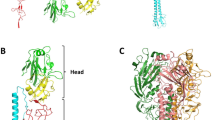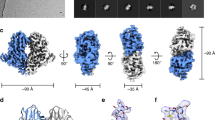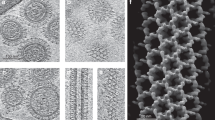Abstract
The complete amino acid sequences of the haemagglutinins (HAs) of one strain of each of the Hav1 and H2 subtypes and of three strains of the H3 subtype of influenza virus have been established1–3. A large external fragment (BHA) of HA can be released from virus particles using the protease bromelain4 that cleaves the protein close to its carboxyl terminus, which is inserted in the virus membrane (see Fig 1). Here we show that a single disulphide bond joins the two component polypeptide chains BHA1 and BHA2 and establish the location of five intrachain disulphides. These disulphide bonds have been located in the three-dimensional structure of HA which is known to 3 Å resolution5,6.
This is a preview of subscription content, access via your institution
Access options
Subscribe to this journal
Receive 51 print issues and online access
$199.00 per year
only $3.90 per issue
Buy this article
- Purchase on Springer Link
- Instant access to full article PDF
Prices may be subject to local taxes which are calculated during checkout
Similar content being viewed by others
References
Porter, A. G. et al. Nature 282, 471–477 (1979).
MinJou, W. et al. Cell 19, 683–696 (1980).
Gething, M. J., Bye, J., Skehel, J. J. & Waterfield, M. D. Nature 287, 301–306 (1980).
Brand, C. M. & Skehel, J. J. Nature new Biol. 238, 145–147 (1972).
Wilson, I. A., Skehel, J. J. & Wiley, D. C. in Structures and Variations in Influenza Virus (Developments in Cell Biology 5) (eds Laver, W G & Air, G ) 339–384 (Elsevier, Amsterdam, 1980).
Wilson, I. A., Skehel, J. J. & Wiley, D. C. Nature 289, 366–373 (1981).
Waterfield, M. D., Espelie, K., Elder, K. & Skehel, J. J. Br. med. Bull. 35, 57–64 (1979).
Waterfield, M. D., Skehel, J. J., Nakashima, Y., Gurnett, A. & Bilham, T. in The Influenza Virus Haemagglutinin (Topics in Infectious Diseases) Vol 3 (eds Laver, W G, Bachmayer, H & Weil, R ) 167–169 (Springer, Vienna, 1978).
McCauley, J., Skehel, J. J. & Waterfield, M. D. in The Influenza Virus Haemagglutinin (Topics in Infectious Diseases) Vol. 3 (eds Laver, W. G., Bachmayer, H. & Weil, R.) 81–192 (Springer, Vienna, 1978).
Dayhoff, M. O. (ed) Atlas of Protein Sequence and Structure Vol. 5, D2 (National Biomedical Research Foundation, Maryland, 1972).
Dopheide, T. A. A. & Ward, C. A. FEES Lett. 110, 181–182 (1980).
Skehel, J. J. & Waterfield, M. D. Proc. natn. Acad. Sci. U.S.A. 72, 93–97 (1975).
Waterfield, M. D. & Scrace, G. T. in Biological/Biomedical Applications of Liquid Chromatography III (ed. Hawk, G.) (in the press).
Author information
Authors and Affiliations
Rights and permissions
About this article
Cite this article
Waterfield, M., Scrace, G. & Skehel, J. Disulphide bonds of haemagglutinin of Asian influenza virus. Nature 289, 422–424 (1981). https://doi.org/10.1038/289422a0
Received:
Accepted:
Issue Date:
DOI: https://doi.org/10.1038/289422a0
This article is cited by
Comments
By submitting a comment you agree to abide by our Terms and Community Guidelines. If you find something abusive or that does not comply with our terms or guidelines please flag it as inappropriate.



